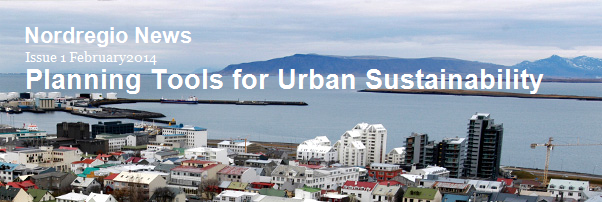
New Technologies, New Tools for Sustainable Planning
Cities are complex assemblages of people, houses, roads, bridges, subways, cars, parks, animals, pipelines, wireless networks, phones, cameras and so on. While technological developments have significantly contributed to this complexity, they also offer new solutions for future urban developments. In this issue of Nordregio News, researchers explore new technologies and new tools for sustainable urban planning. From different perspectives the three articles provide new insights on innovative planning tools and models for managing complexity at different scales.
Read more
Urban Form and Sustainability: the Planner's Toolbox
By Ryan Weber, Lars Berglund & Christian Fredricsson
Planners and policymakers face the difficult task of working in a complex, interconnected and ever-changing world. They face challenging decisions regarding the design of policies for sustainable development, because the integrated management of different types of land use involves systems in which natural and human factors are closely interconnected. This includes the struggle to balance the demands of growth with the desire to preserve the natural environment and other quality-of-life attributes - all while ensuring that the interests of many actors are acknowledged and accommodated.
Read more
Sustainability Certification of Neighbourhoods: Experience from DGNB New Urban Districts in Denmark
By Jesper Ole Jensen
With increasing urbanization and political ambitions to reduce the
environmental impact of cities, urban leaders are faced with immense challenges. The pursuit of CO2 reduction has left other sustainability targets somehow overlooked, but not less relevant. This includes environmental issues such as water supply, management of rainwater, transport and the localization and production/protection of green areas. It also includes social sustainability issues such as how to ensure a balanced mix of both residential and other land uses, how to integrate meeting places in the city and to allow a sharing of facilities. Important economic issues also include considerations of how an urban development influences the city economy. One planning tool that has recently emerged to help planners balance these sustainability issues is neighbourhood certification schemes, including the DGNB1 New Urban Districts certification scheme.
Read more
Urban Planning and Big Data – Taking LUTi Models to the Next Level?
By Joan Serras, Melanie Bosredon, Ricardo Herranz & Michael Batty
Cities are growing very rapidly worldwide. This growth entails many challenges which cut across different city layers. In terms of demography, we are facing many issues to do with migration and aging of the population. In terms of land use, a big challenge involves how we deal with congestion in terms of high densities and sprawl in cities and also how we can tackle segregation so that we might decrease inequality and deprivation. The availability of resources is of concern in terms of how efficiently and sustainably we use energy. The transport sector faces big tests with respect to congestion in infrastructure across all travel modes, growing levels of pollution and noise, and accidents. To add to the complexity of the challenges just mentioned, they span different spatial and temporal scales as well.
Read more
Back to Nordregio News